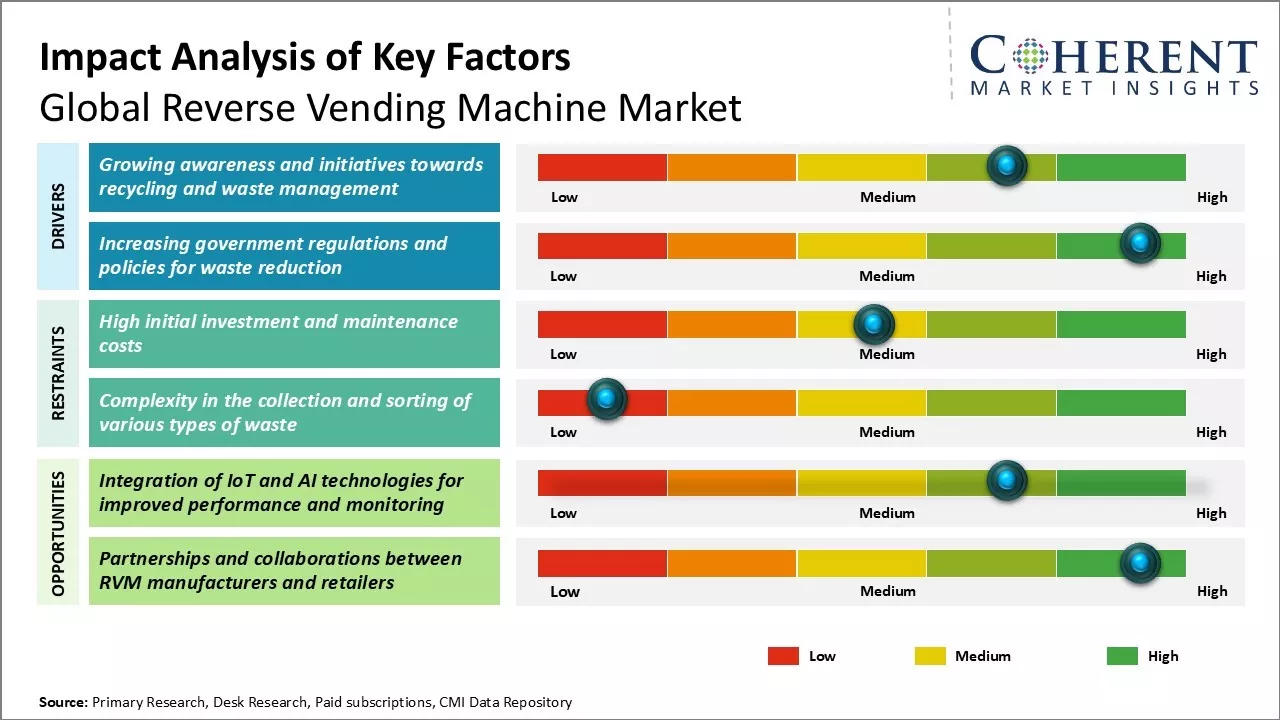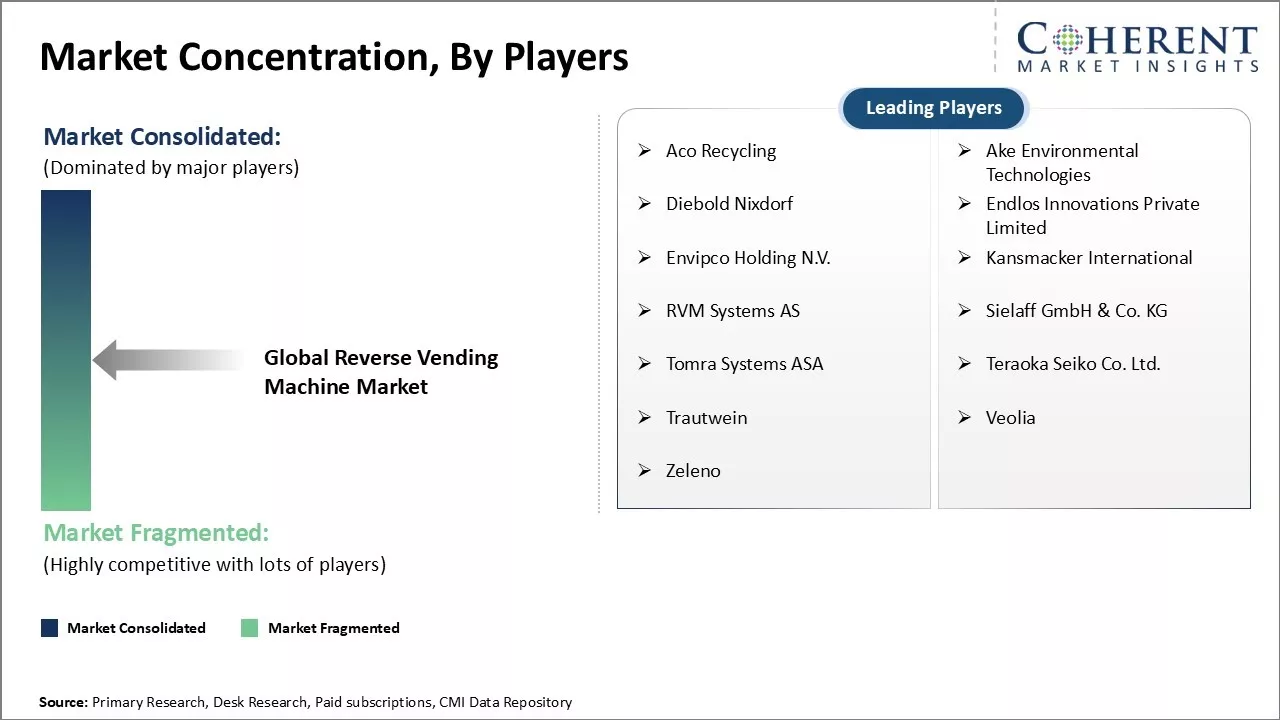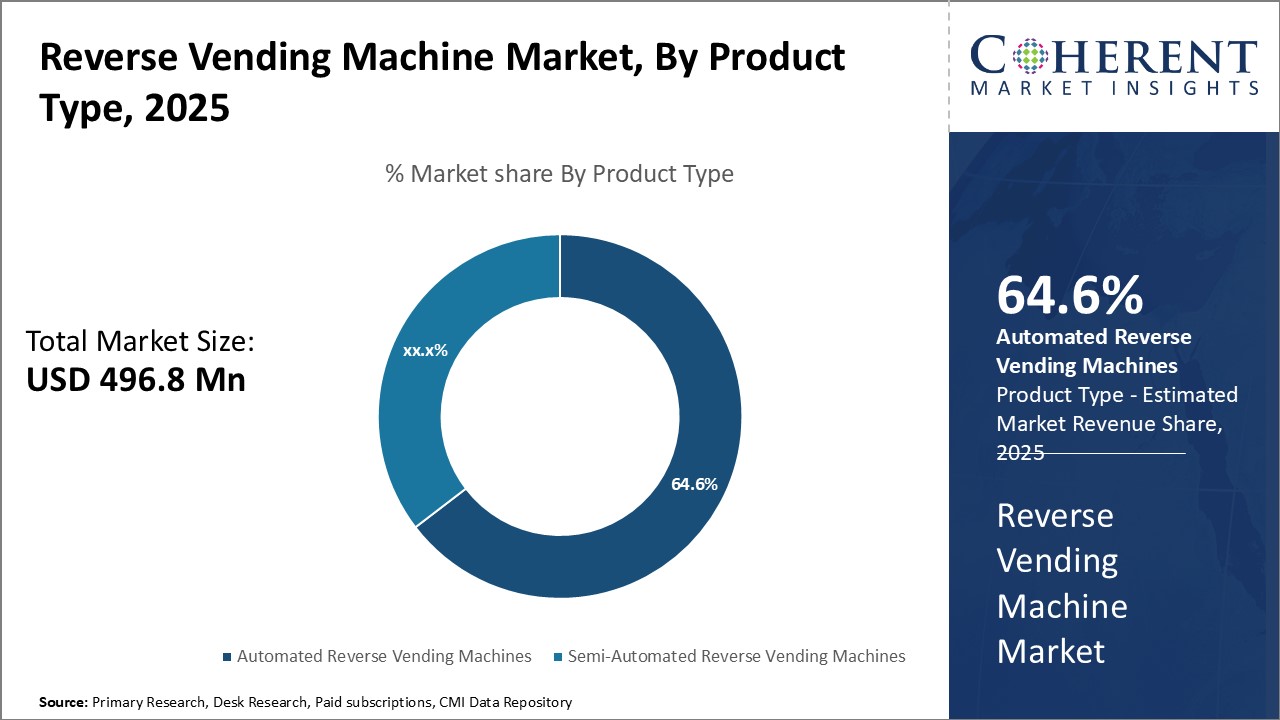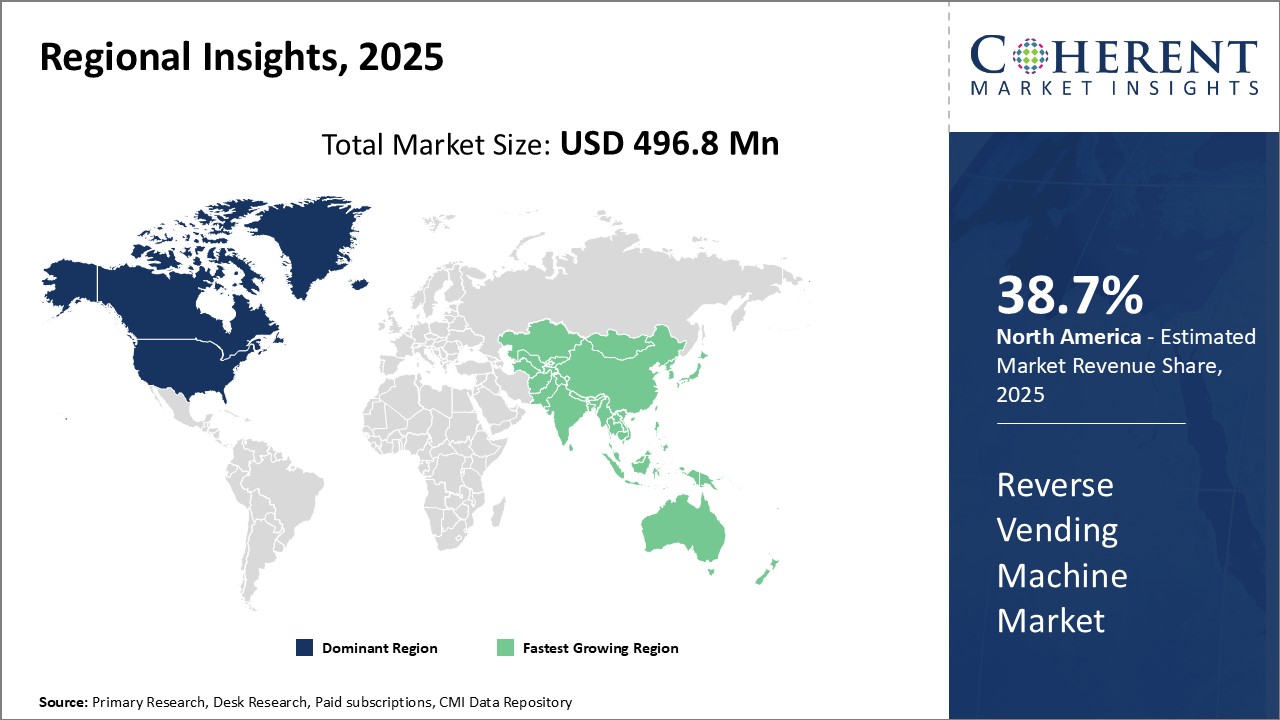Reverse Vending Machine Market Size and Trends
The Global Reverse Vending Machine Market is estimated to be valued at USD 496.8 Mn in 2025 and is expected to reach USD 752.5 Mn by 2032, exhibiting a compound annual growth rate (CAGR) of 6.1% from 2025 to 2032.

Discover market dynamics shaping the industry: Download Free Sample
Reverse vending machines help consumers deposit used beverage containers and get incentives in return. This has boosted the demand for reverse vending machines around the world.
Growing awareness and initiatives towards recycling and waste management
With growing concerns around the environment and its protection, recycling has become an important part of mainstream conversation in recent years. People understand now more than ever the need to reduce landfill waste and how recycling can help achieve sustainability goals. Reverse vending machines integrate seamlessly with recycling efforts by offering an easy and rewarding way for consumers to dispose their used bottles and cans. These machines not only ensure materials are recycled but also incentivize participation through refundable deposits or reward points. With reverse vending, recycling is simplified - people can just drop their empty containers in and go, without having to separately sort materials.
With visibility of recycling and rewarding mechanics, the use of these machines has become a social norm in many regions. Schools and offices have installed reverse vending to inculcate good waste management habits in children as well as employees. Many communities assist non-profit drives by hosting recycling drives centered on reverse vending. With growing proliferation on digital media, more people are recognizing the benefits of such machines not only for themselves but for the planet. If the momentum continues, reverse vending will become ubiquitous and strongly complement worldwide moves towards circular economy.
Market Concentration and Competitive Landscape

Get actionable strategies to beat competition: Download Free Sample
Increasing Government Regulations for Waste Reduction
With climate change looming large, governments worldwide are under mounting pressure to curb pollution and cutback on dumping of municipal solid waste. Stricter legislations around waste management and recycling targets have been put forth. While regulators are determined to meet sustainability objectives, they need active participation from citizens to achieve results. Reverse vending machines can be instrumental here by offering a regulated automated solution. Regulators are thus promoting the use of reverse vending to formalize the collection of recyclable packages within their jurisdictions. Deposit-refund schemes mandating refundable deposits on sold beverage containers are being paired with widespread installations of reverse vending machines. This ensures high returns are secured for reformulated containers in addition to tracking recycling rates.
With their ability to identity container types, reverse vending also enable regulators to monitor recycling streams. They provide analytics on material recovery trends that support policymaking. Non-compliant waste operators are declining as reverse vending bring transparency to recycling streams. To motivate adoption, several regions are offering subsidies to municipalities or retailers taking initiative for reverse vending integration. Compliance is set to rise further as new regulations tighten, expanding the market for reverse vending services and technology. While regulations may seem daunting to businesses, reverse vending presents an optimized means to satisfy such obligations, benefiting all stakeholders in the long run.
Key Takeaways from Analyst:
The global reverse vending machine market is expected to witness steady growth over the forecast period driven by rising environmental concerns and increased adoption of recycling practices worldwide. Stringent government regulations regarding proper waste disposal will also push adoption of reverse vending machines. Various programs launched by authorities to promote recycling and offer incentives to users of these machines work in favor of the market.
However, high initial costs associated with purchase and installation of reverse vending machines could negatively impact their demand to some extent. Many potential buyers may be discouraged by the high capital expenditure required. Additionally, requirement of frequent emptying and maintenance services adds to the overall operating costs.
North America currently dominates the global market owing to strong reuse and recycling policies. Presence of leading recycling organizations along with high per capita consumption of packaged beverages makes the region highly lucrative. Going forward, the Asia Pacific market is anticipated to grow at the fastest pace supported by increasing recycling rates in high population countries like India and China.
Overall, rising environmental awareness and evolving consumer preferences towards sustainable packaging are expected to drive more organizations to install reverse vending machines and bolster the recycling infrastructure. The market is likely to receive a boost as these machines enable simple and convenient waste disposal for users.
Market Challenge - High initial investment and maintenance costs
The global reverse vending machine market faces significant challenges due to high initial investment costs required to purchase and set up the reverse vending machines. These machines employ complex automation technologies to identify, sort and temporarily store used containers before returning monetary deposits. Additionally, ongoing maintenance and repairs of the sophisticated sensing and sorting components adds to significant operating expenses over the lifecycle of the machines. As the returned containers often require cleaning before further processing, maintenance costs also include those required for regular washings and sanitation of the containers held within the machines. For manufacturers and vendors, the high capital expenditure poses entry barriers, while for municipal agencies and retailers considering deployment, the total cost of ownership acts as a deterrent. Revenue models based on subsidy programs or deposit-return schemes would need to guarantee adequate returns to incentivize wider adoption.
Market Opportunities: Integration of IoT and AI technologies for improved performance and monitoring
The global reverse vending machine market presents significant opportunities for players who integrate latest IoT and AI-enabled technologies. Integration of IoT allows for remote monitoring of machine performance and distributions of returned containers. This helps optimize collections, transportation and assignment of containers to recycling facilities. Use of AI-powered computer vision and deep learning algorithms can enhance accuracy of identification and sorting of diverse types of containers. Additionally, predictive maintenance techniques using IoT sensors cut downtime and servicing costs of the machines. For consumers, integration of mobile apps starring deposit balances and redemption points improve convenience. Such innovations address current limitations and help strengthen value propositions for key stakeholders throughout the reverse supply chain.

Discover high revenue pocket segments and roadmap to it: Download Free Sample
Insights By Product Type - Machines meet evolving consumer demand for convenience owing to:
In terms of product type, the automated reverse vending machines segment is expected to contribute 64.6% share of the market in 2025 owing to their ability to streamline the returns process and offer consumers a convenient recycling option. As consumers seek out ways to reduce waste and contribute to sustainability efforts with minimal effort, automated machines have grown in popularity. Their self-service functionality allows returns to be made round the clock without requiring assistance. This addresses the need for flexibility in recycling without being constrained by store operating hours or dependent on available staff. Furthermore, automated counting and sorting of items translates to immediate credit for the consumer, respecting their time and incentivizing participation. Such benefits of speed, ease of use and a rewarding experience have resonated well with busy modern lifestyles and subscription-based consumption patterns prevalent across several consumer segments.
Insights By Material Type - Cans gain traction from portability and material attributes driving reuse
In terms of material type, the cans segment is expected to contribute 43.1% share of the market in 2025 owing to their highly portable design and material properties promoting reuse. As consumers increasingly seek beverages and food products designed for on-the-go consumption, cans have outpaced other options due to their compact dimensions and lightweight nature. Their steel composition makes cans durable for transportation and storage without risk of breakage. Additionally, the airtight seal of cans preserves freshness and maintains quality of contents regardless of handling during return transport. These attributes lift confidence in the potential for cans to have multiple lifecycles if effectively collected and recycled. With sustainably-minded practices on the rise, cans appeal greatly to those seeking packaging optimized for reuse in the circular economy.
Insights By End User - Retail integration supports impulse returns and builds store loyalty
In terms of end user, the retail stores segment is expected to contribute 54.2% share of the market in 2025 owing to their integration within the consumer shopping experience. With retail outlets accounting for a major portion of product sales, their ability to facilitate associated returns through on-site machines proves convenient. Locating reverse vending directly in stores allows returns to form part of routine shopping trips versus requiring a dedicated effort. This encourages impulse participation and higher retrieval rates and volumes. At the same time, offering recycling options to store patrons can nurture brand loyalty through civic engagement. Stocking reusable bags or store credit as rewards further sweetens the value proposition. Where sustainable habits are less instinctive, such collaborative retail models have shown promise in driving broader adoption of recycling and the circular economy.
Regional Insights

Need a Different Region or Segment? Download Free Sample
In North America, the dominance in the reverse vending machine market with an estimated 38.7% share in 2025 is largely driven by well-established recycling infrastructure, stringent regulatory standards, and high consumer participation due to environmental consciousness. The U.S. is a significant contributor, partly due to statewide initiatives like bottle bills that offer financial incentives for recycling, enhancing the adoption of reverse vending machines. Additionally, the presence of key market players who are actively innovating and integrating advanced technologies contributes to the market's growth and sustains North America's leadership position. Conversely, the Asia Pacific region is experiencing rapid growth in the reverse vending machine market, spurred by several key factors. The region's swift economic development and urbanization have led to increased consumption of packaged beverages, hence generating more recyclable waste. With growing environmental awareness, consumers in Asia Pacific are more inclined toward sustainable practices. Governments in this region are also establishing stringent waste management regulations and promoting recycling efforts, which include the deployment of RVMs. The combination of socio-economic dynamics, policy-driven initiatives, and investments from both local and international businesses contribute to the swift expansion of the reverse vending machine market in the Asia Pacific, setting the pace for its rapid growth trajectory.
Market Report Scope
Reverse Vending Machine Market Report Coverage
| Report Coverage | Details | ||
|---|---|---|---|
| Base Year: | 2024 | Market Size in 2025: | USD 496.8 Mn |
| Historical Data for: | 2020 To 2024 | Forecast Period: | 2025 To 2032 |
| Forecast Period 2025 to 2032 CAGR: | 6.1% | 2032 Value Projection: | USD 752.5 Mn |
| Geographies covered: |
|
||
| Segments covered: |
|
||
| Companies covered: |
Aco Recycling, Ake Environmental Technologies, Diebold Nixdorf, Endlos Innovations Private Limited, Envipco Holding N.V., Kansmacker International, RVM Systems AS, Sielaff GmbH & Co. KG, Tomra Systems ASA, Teraoka Seiko Co. Ltd., Trautwein, Veolia, and Zeleno |
||
| Growth Drivers: |
|
||
| Restraints & Challenges: |
|
||
Uncover macros and micros vetted on 75+ parameters: Get instant access to report
Reverse Vending Machine Industry News
- In March 2023, Alpla-Werke Alwin Lehner GmbH & Co KG, a global leader in the development and production of innovative plastic packaging solutions, announced its acquisition of a stake in Plastic Bank, a Canadian organization dedicated to reducing plastic waste and promoting recycling in developing countries.
- In August 2022, Tomra Systems ASA, a leader in reverse vending technology, launched the TOMRA M1, the smallest three-material reverse vending machine on the market. The TOMRA M1 occupies just 0.62 square meters of floor space, making it ideal for smaller retailers to engage in deposit return schemes and promote recycling. This compact machine is specifically designed to meet the needs of convenience and small stores, facilitating their participation in sustainability efforts.
- In November 2021, Aco Recycling, a specialist in reverse vending machines and advanced waste monitoring systems, unveiled the G-1 Smart Reverse Vending Machine. This AI-powered device simplifies the recycling of plastic, glass, and aluminum waste, while also providing users with a remote monitoring solution to track the machine's status.
- In June 2021, EcoVend Reverse Vending, a company specializing in innovative recycling solutions, installed its new RVM 400 reverse vending machines in one of Portugal's leading supermarkets, which accept plastic bottles for recycling. Following this, in August 2021, EcoVend introduced an upgraded version of the RVM 400, featuring enhanced speech and touchless control capabilities, along with a large advertising screen to engage users.
*Definition: The Global Reverse Vending Machine Market consists of automated machines that accept empty beverage containers such as bottles and cans and issue a cash refund or a voucher. These machines allow consumers to conveniently return empty containers for recycling in exchange for monetary credits. They are an innovative solution that makes recycling easy while encouraging responsible waste disposal. They also benefit brands and retailers through improved collection of containers under deposit-return schemes.
Market Segmentation
- By Product Type Insights (Revenue, USD Mn, 2020 - 2032)
-
- Automated Reverse Vending Machines
- Semi-Automated Reverse Vending Machines
- By Material Type Insights (Revenue, USD Mn, 2020 - 2032)
-
- Cans
- Bottles
- Others (Plastic, Glass, etc.)
- By End User Insights (Revenue, USD Mn, 2020 - 2032)
-
- Retail Stores
- Public Places (Airports, Malls, Parks, etc.)
- Educational Institutions
- Others
- By Regional Insights (Revenue, USD Mn, 2020 - 2032)
-
- North America
- U.S.
- Canada
- Latin America
- Brazil
- Argentina
- Mexico
- Rest of Latin America
- Europe
- Germany
- U.K.
- Spain
- France
- Italy
- Russia
- Rest of Europe
- Asia Pacific
- China
- India
- Japan
- Australia
- South Korea
- ASEAN
- Rest of Asia Pacific
- Middle East
- GCC Countries
- Israel
- Rest of Middle East
- Africa
- South Africa
- North Africa
- Central Africa
- North America
- Key Players Insights
-
- Aco Recycling
- Ake Environmental Technologies
- Diebold Nixdorf
- Endlos Innovations Private Limited
- Envipco Holding N.V.
- Kansmacker International
- RVM Systems AS
- Sielaff GmbH & Co. KG
- Tomra Systems ASA
- Teraoka Seiko Co. Ltd.
- Trautwein
- Veolia
- Zeleno
Share
Share
About Author
Ramprasad Bhute is a Senior Research Consultant with over 6 years of experience in market research and business consulting. He manages consulting and market research projects centered on go-to-market strategy, opportunity analysis, competitive landscape, and market size estimation and forecasting. He also advises clients on identifying and targeting absolute opportunities to penetrate untapped markets.
Missing comfort of reading report in your local language? Find your preferred language :
Transform your Strategy with Exclusive Trending Reports :
Frequently Asked Questions
EXISTING CLIENTELE
Joining thousands of companies around the world committed to making the Excellent Business Solutions.
View All Our Clients
